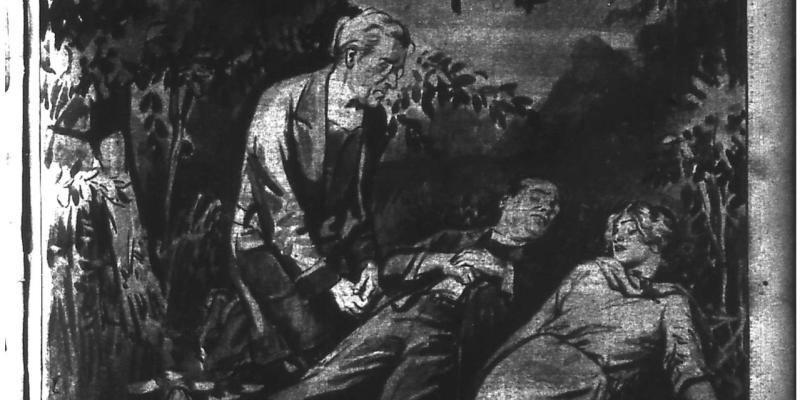'Blood & Ink' Review: A Crime Fit to Print
By: Tom Nolan (WSJ)



It was called "the great story of a generation." In September 1922, the Rev. Edward Hall and his lover, Eleanor Mills, a member of his church's choir, were found murdered near New Brunswick, N.J. Both were shot dead, their bodies laid out on a field beneath a crabapple tree. Eleanor's throat was slashed, and her letters to the married cleric were scattered around their corpses.
For at least two years, writes Vanity Fair correspondent Joe Pompeo in his engrossing "Blood & Ink: The Scandalous Jazz Age Double Murder That Hooked America on True Crime," Hall and Mills had been carrying on an ill-concealed affair. During one argument, Eleanor bluntly told her husband, Jim, sexton at Hall's church: "I care more for Mr. Hall's little finger than I do for your whole body."
Dozens of journalists from all over the country streamed into town, and the mystery became “a front-page sensation from New Brunswick to California,” as Mr. Pompeo writes. Thousands of sightseers flocked to the scene, looting the “house of mystery” where the lovers had rendezvoused, carrying off furniture, stripping the ivory from the piano’s keys. They even peeled the crabapple tree down to its bare branches.
Meanwhile, authorities fumbled through a botched investigation. So inadequate were the victims’ initial autopsies that their bodies were exhumed for a second examination. Who was the killer? Eleanor’s daughter Charlotte thought the reverend’s wife, Frances, was involved. Others suspected Eleanor’s husband. The local prosecutor, under pressure from the governor and the press, came up with a dark horse to charge: a friend of one of the two young people who discovered the bodies. After a key witness recanted, though, the accused man was released.
The authorities found a new lead via Jane Gibson, a shotgun-toting, mule-riding woman who kept a farm near the murder site and claimed to have witnessed the crime. Dubbed “the Pig Woman” by the press, she gave varying accounts of what she’d seen. A grand jury brought no indictments, and “the homicide investigation,” Mr. Pompeo writes, “fizzled to a tepid denouement.”
Mr. Pompeo’s book is as much about the rise of tabloid journalism and the American public’s appetite for lurid true-life tales as it is about the crime itself. The case lay dormant until Phil Payne of the New York Daily News teamed with Ellis Parker, a prosecutor’s investigator from another county. The two men conducted their own probe, focusing at first on Eleanor’s widower-husband.
Spiritualism was then in vogue, thanks in part to the endorsement of Arthur Conan Doyle, the creator of Sherlock Holmes. Payne hatched a scheme to scare Jim Mills into a confession: He got him to attend a fake séance at which a reporter posed as “Madame Astra” and accused him of being the killer. Jim vehemently denied the charge. Undeterred, Payne induced the cooperation of a police detective to gain access to the official files—and continued his own independent inquiry, which the governor endorsed. “This mutually beneficial arrangement,” Mr. Pompeo writes, “reflected a well-established tradition . . . in which newspapers actively interfered in criminal investigations.”
Mr. Pompeo revisits the heyday of the tabloid papers, with their emphasis on vivid photographs and sensationalist stories. Tabloid journalism, he contends, “shaped the modern world. . . . The Hall-Mills mystery and other tabloid crimes of Jazz Age New York were the zeitgeist-setting murder podcasts and Netflix documentaries of their day.”
Newspaper tycoon William Randolph Hearst, prompted by the phenomenal success of the Daily News, started the New York Daily Mirror in 1924—and hired Payne to manage it. “If the Daily News was unashamedly down-market,” writes Mr. Pompeo, “the Mirror was positively vulgar. . . . News stories in the inaugural issue included a wife-slaying, an attempted wife-poisoning, and a dead priest.”
Bernarr Macfadden’s New York Evening Graphic, launched the same year, introduced the composograph, “in which the faces of story subjects were superimposed on body doubles. It was an outrageous way to illustrate sensational news events.” The most extensive coverage of the Hall-Mills affair, though, appeared in the august New York Times—whose publisher, Adolph Ochs, took pains to distinguish its reportage from that of its lower-class rivals.
It was the Daily Mirror that prompted a reopening of the Hall-Mills case in 1926—four years after the murders—in response to new evidence gathered by Payne. This time, a grand jury decided that Frances Hall and three others should be indicted. Over 200 journalists attended “the trial of the century.” The Pig Woman, gravely ill, testified before the court while lying in a hospital bed and accompanied by a doctor in close attendance. Her own mother, “a gnarled old woman dressed in black,” blurted out from the front row: “She’s a liar. A liar, liar, liar.” The defendants were acquitted.
Decades passed. “Every person at the center of this story took his or her truth to the grave,” Mr. Pompeo writes. Yet as late as 1969, the affair was still prompting official scrutiny. Three previous full-length works have been written about it. Mr. Pompeo calls his own account “the most comprehensive and exhaustively researched book about the Hall-Mills case,” and his speculations continue past his epilogue into his acknowledgments and notes on sources. “Even now, a whole century later,” he writes, “the million-dollar question remains: Whodunnit ?”







It's not just the tabloids that have taken advantage of lurid details and salacious pictures....
